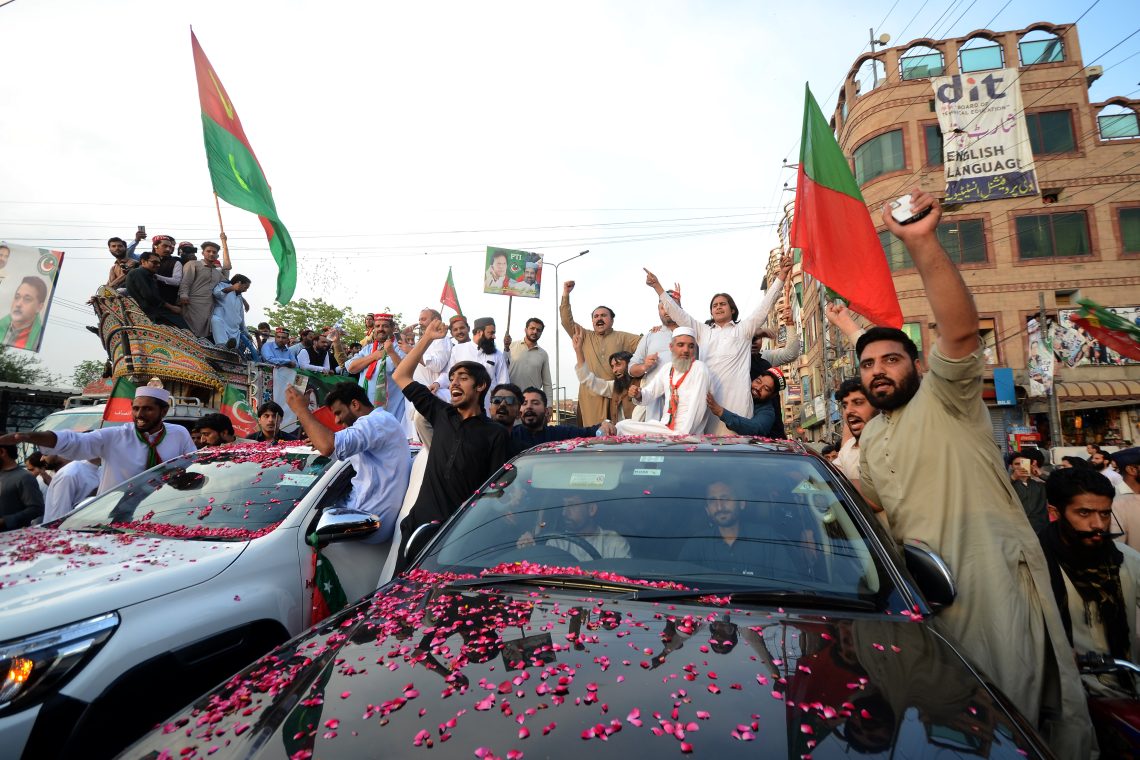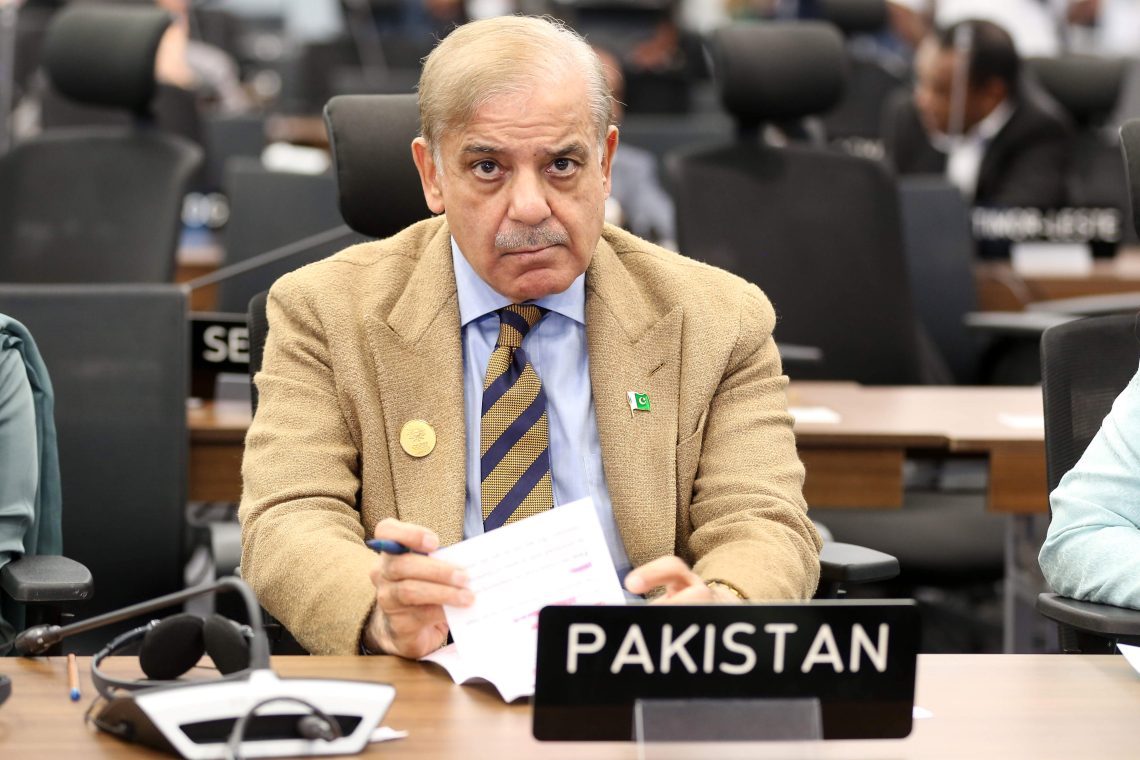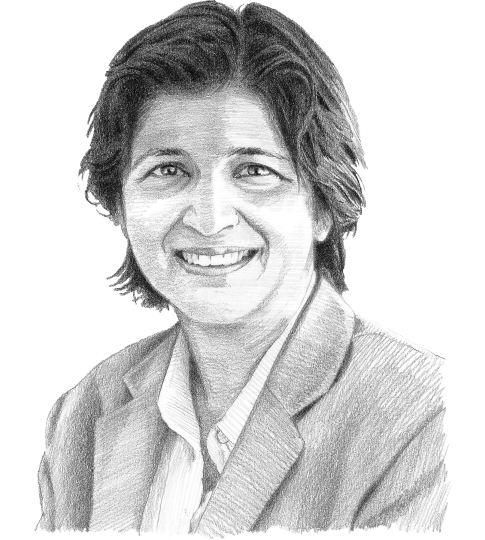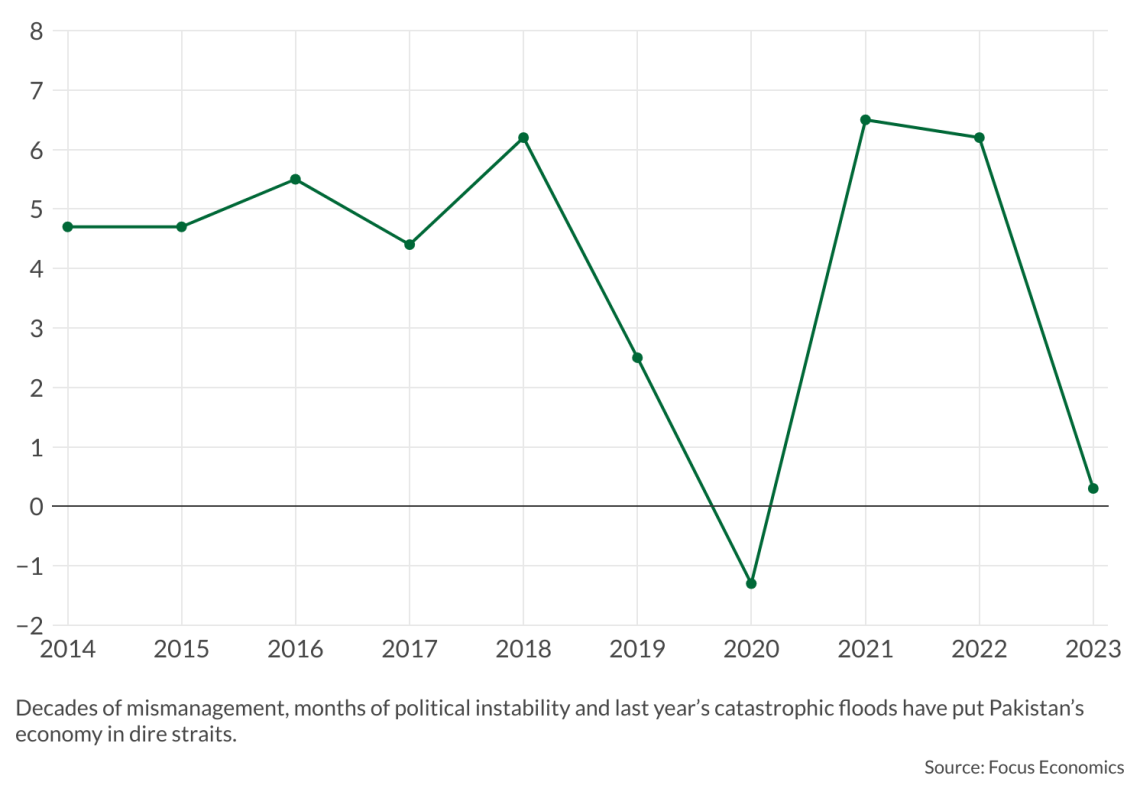Pakistan’s economy shudders as army confronts its own mess
Political chaos, economic crisis and security threats test Pakistan’s fragile state as the military seeks to retain control.

In a nutshell
- Decades of military rule have brought Pakistan to the brink of default
- Riots over ousted Prime Minister Khan show risks of stage-managed politics
- A split fall election result is the generals’ best chance to reassert control
Pakistan enters its 76th year of independence as a brittle state with a dysfunctional polity, a radicalized populace, and weak external relations. Despite last month’s agreement with the International Monetary Fund on a $3 billion Stand-By Arrangement (SBA), the economy remains in terrible shape with the payments balance under heavy pressure. The nine-month loan facility simply buys Islamabad a little time to seek other credit lines.
Meanwhile, the country’s internal security is deteriorating. Islamic extremists from the Tehreek-e-Taliban Pakistan (TTP) are continuing their attacks on official targets, but from the standpoint of the Pakistani security establishment, a more immediate threat is posed by former Prime Minister Imran Khan and his supporters. Mr. Khan was removed by a no-confidence vote in April 2022 after his scheme to instigate a revolution against the all-powerful military establishment backfired. The military struck back with full force, becoming even more powerful, but also plunged the country into a political standoff.
Longer term, the economy may prove to be the stiffer challenge because it is not so amenable to military control as politics and internal security. The difficulty is compounded by Pakistan’s fraught foreign relations, as the government can no longer automatically count on largesse from its allies in the United States and the Middle East, who in the waning years of the Cold War and immediately afterward allowed the country to service its debt and stay afloat as a rentier state. Boosting exports could be a nonstarter because of the military’s reluctance to mend trade ties with India.
Pakistan still hopes the U.S., China, and other international partners will step in to help it avoid defaulting on international loans. But their willingness to become involved is limited by worries about Pakistan’s security situation. Islamabad’s continued obsession with India, at a time when its traditional partners in Western and Gulf capitals have become increasingly concerned about Russia and China, has created a dangerous divergence in strategic worldviews. That divergence helps explain why negotiations with the IMF dragged out to the very last minute, and why Pakistan was forced to accept such onerous economic conditions to obtain the loan.
Financial crisis
Pakistan’s economic fundamentals remain problematic. Inflation stands at 38 percent, the highest since 1957. The government estimates gross domestic product (GDP) grew at just 0.3 percent for the July 2022-June 2023 fiscal year, with the industrial sector contracting by 3 percent. Pakistan is still suffering the aftereffects of the devastating August 2022 floods, which caused agricultural output to fall for the first time in two decades. Remittances from overseas workers declined by 13 percent and foreign exchange reserves stand at only $4.1 billion, just enough to cover a month’s worth of imports.
For the 2023-2024 fiscal year, Pakistan faces $22 billion in external debt payments. To avert default, the government has imposed severe import restrictions, relaxed only for essential goods like fuel, machinery and medicines. This policy has led to factory closures and plunged the industrial sector into recession.
Facts & figures
The recent federal budget announced by the coalition government of Prime Minister Shehbaz Sharif, leader of the center-right Pakistan Muslim League-Nawaz (PML-N), is trying to use higher tax rates to balance populist policies and increased defense spending. Even so, the budget depends on expectations of much-needed external financing from multilateral institutions and friendly countries.
Pakistan’s dire economic straits are a legacy of decades of mismanagement, refusal to implement reforms and overspending on defense. Yet even as its economy faces an existential crisis, the defense allocation was increased by 13 percent. The military establishment’s sole aim seems to be to avoid a sovereign default like Sri Lanka’s last year. Until parliamentary elections are held (no later than November 10), the government seems content to juggle the books and blame former Prime Minister Khan for the mess.
Chosen allies
Pakistani society remains deeply polarized not just on political but also on ethnolinguistic lines, beset by the continued insurgency in Balochistan along with the demands for devolution by Pashtun, Sindhi and Muhajir nationalists. Decades of support for radical Islamist organizations and militant groups, a key element of Pakistan’s regional policy aimed at weakening India, has led to the flourishing of numerous jihadi groups, which occasionally attack inside Pakistan as well.
Since August 2021, when the Taliban took power in Afghanistan, Pakistan has been under steady attack by the TTP and its affiliates. In 2022, 365 terrorist attacks took place inside Pakistan, killing 971 civilians, terrorists and security personnel. The first half of 2023 brought 187 attacks and 572 more deaths.
The Pakistani deep state has always viewed the Islamist groups, rather than traditional political parties or civil society, as its allies of choice. That policy continues. The outfits that came out in support of the deep state when Mr. Khan forced a confrontation last year were Islamist groups and political parties like Jamiat Ulema-e-Pakistan and Tehreek-e-Labbaik Pakistan (TLP).
More on Pakistan
The fragile state of Pakistan
Crisis and instability threaten Pakistan’s economy yet again
Political engineering
Pakistan remains in political chaos 15 months after the April 2022 vote of no confidence against the government of cricketer-turned-celebrity, Imran Khan. He came to power in 2018 when the Pakistani military rigged elections to ensure his victory, even though his Pakistan Tehreek e-Insaf (PTI) party did not obtain a majority. His entire cabinet was filled with former officers or politicians and technocrats who had worked with every military government over the decades, yet the new prime minister seemed to think he had a popular mandate allowing him to dictate terms. This hubris, along with Mr. Khan’s lack of executive experience and populist rhetoric, doomed his regime.
Ever since his ouster last year, Mr. Khan has tried to force the army’s top brass to reconsider its decision to withdraw support. That has piled pressure on Prime Minister Sharif’s successor coalition government, led by the PML-N, which finds its every action on the political or economic front challenged by Mr. Khan and his cult-like following.
The situation shows how Pakistan’s decades-old experiment with democracy continues to flounder because of the army’s refusal to allow civilian supremacy. Over the past seven decades, the military has indulged in political engineering, always seeking a malleable figure who could win elections and implement the army’s preferred domestic and foreign agenda, while remaining beholden to them. Prime Minister Khan was not the first and will not be the last civilian whom the army brought to power with the hope that the resultant “hybrid regime” would provide political and economic stability.

King’s party
Prime Minister Khan’s calculations were not wholly without merit. He counted on his popularity among military families, who hate the older political parties, and more generally for his support among the young population. His expectation was that polarizing the country would force the military to take him back. That led Mr. Khan’s followers to attack military installations across the country on May 9 after he was arrested on corruption charges.
Mr. Khan had assumed that the mass riots would undermine support within the army for Chief of Staff Asim Munir. Instead, the attacks gave General Munir an opportunity to assert his control over the military and society as a whole. The actions taken against Mr. Khan and the PTI have less to do with any personal or ideological animus and more to do with the army seeking to clean up a mess of its own creation.
General Munir realizes that the military made a mistake in supporting an unreliable populist and is now keen to restore the power and prestige of his institution. The current situation gives him every opportunity to do so. As Mr. Khan rants against the military establishment and his political rivals, his political party is crumbling.
Mr. Khan’s PTI is facing a dilemma familiar to every political party in Pakistan that has been endorsed by the military. Once the generals decided to withdraw their support, PTI leaders close to the military promptly jumped ship and joined a new “king’s party” – in this case, the Istehkam-e-Pakistan Party (Pakistan Stability Party, or IPP) led by the industrial magnate and establishment-politician Jahangir Tareen. Other former associates of Mr. Khan are in discussions with Pakistan’s traditional mainstream parties, Bilawal Bhutto Zardari’s left-wing Pakistan’s Peoples Party (PPP) and Prime Minister Sharif’s right-of-center PML-N, which dominates Punjab, home to more than half the country’s population.
Scenarios
What happens next depends mainly on four key actors: the ubiquitous military, Imran Khan, the traditional political parties and the judiciary. The military’s aim is twofold: to prevent Mr. Khan from returning to power, and to deny an absolute majority to any single party in this autumn’s general elections, thus ensuring the army retains influence over any future coalition government.
The military knows that Mr. Khan enjoys some support within the highly politicized judiciary through family and other personal connections. Instead of risking more nationwide riots by trying to arrest him again, the generals appear content to wear him down with multiple court cases and a ban from appearing on national television. Meanwhile, Mr. Khan’s party has splintered between those who have joined the military-backed IPP and a rump PTI left leaderless after Mr. Khan’s disqualification on corruption charges.
With Mr. Khan at least temporarily out of the way, the most likely scenario is for elections to be held either in October or November 2023, depending on whether the National Assembly is dissolved before or at the end of its five-year term in August. As stipulated by the constitution, elections are held by a caretaker government appointed by the president after consultation with the prime minister and leader of the opposition. The PTI’s fracture leaves no real obstacle to appointing a suitable candidate in consultation with Pakistan’s Election Commission. Historically, technocrats or retired justices have been the preferred candidates to lead such interim cabinets, which stay in power for two or three months to ensure free and fair elections are held.
From the military’s point of view, the ideal election outcome would be a split result, leaving no party with a majority at the federal level and making sure that whichever party leads the federal government does not also control Punjab.
While the outlines of this “divide and rule” strategy are clear, the military has not always been a good forecaster of election results, leaving open the possibility of a surprise. This became even more likely with the National Assembly’s recent decision to cap bans on holding political office at five years, opening the door to a possible return by three-time Prime Minister Nawaz Sharif, now exiled in London, which could substantially improve the chances of his PML-N party.
Another crucial factor is an emerging rift between the army brass and Pakistan’s Supreme Court. Historically, the court has sided with the military intelligence faction of the army leadership. Recent years, however, have witnessed an upsurge of judicial activism with underlying Islamist and populist elements.
The current Chief Justice, Umar Ata Bandial, has openly sided with Imran Khan and both the Supreme Court and High Court have offered him bail on every case brought against him. There is a possibility the courts could take a hand in the timing of the elections if any legal challenges are made. It should be noted, however, that Mr. Bandial retires in the middle of September and his successor does not sympathize with Mr. Khan. That makes an open clash between the military and the judiciary a less likely scenario.
Recently, the chief spokesperson for military intelligence held a press conference that lasted two and a half hours to warn that domestic security was the biggest threat facing Pakistan. This suggests that a domestic emergency brought on by political instability and economic pressures might force the army leadership to step in and impose a technocratic government. On balance, however, direct military rule appears highly unlikely, though in Pakistan’s case, it can never be ruled out.










